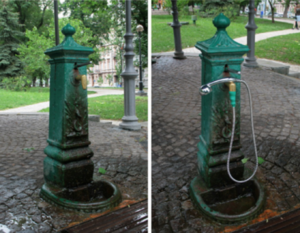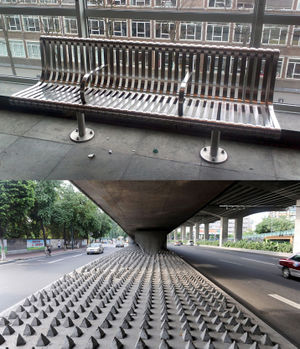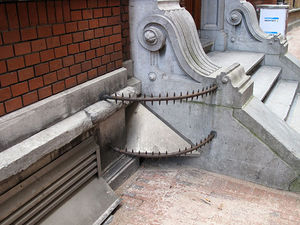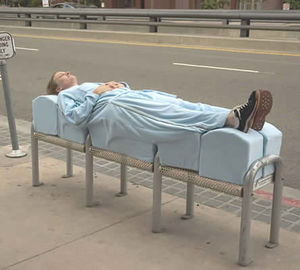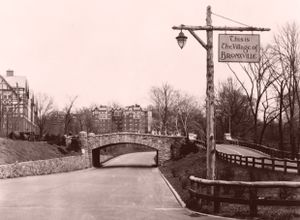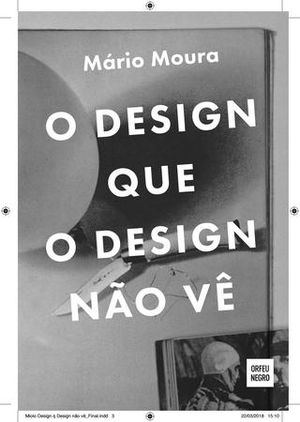Hack-16-10-2018: Difference between revisions
(Created page with "SPACE HACKS Motivated by the presentation made by the other groups, more concretely Artemis, Paloma and Bi's presentation. I've decided to explore more about the space hacks...") |
No edit summary |
||
| (10 intermediate revisions by the same user not shown) | |||
| Line 1: | Line 1: | ||
SPACE HACKS | SPACE HACKS | ||
[[File:Img11111.png|thumbnail|left|Img—1 A+P+B Presentation Image]] | |||
[[File:Img1and2.jpg|thumbnail|left|Img2,3—Unpleasant design hacks]] | |||
Motivated by the presentation made by the other groups, more concretely Artemis, Paloma and Bi's presentation. I've decided to explore more about the space hacks in the city. I also focused on the design made by/for the minorities. | Motivated by the presentation made by the other groups, more concretely Artemis, Paloma and Bi's presentation. I've decided to explore more about the space hacks in the city. I also focused on the design made by/for the minorities. | ||
| Line 5: | Line 8: | ||
We may see traces of how they have adapted and how the city adapted to them also in some kind of a two-way fight. | We may see traces of how they have adapted and how the city adapted to them also in some kind of a two-way fight. | ||
[[File:Deflector.jpg|thumbnail|left|Img—4 Urine Deflector]] | |||
While in a meeting of all XPUB 1 students we have approach different hacks to space and mentioned unpleasant design as one strategy found to cope with homeless people (image 2—3) or even, for example, the creation of Urine Deflectors around the cities (image 4) | While in a meeting of all XPUB 1 students we have approach different hacks to space and mentioned unpleasant design as one strategy found to cope with homeless people (image 2—3) or even, for example, the creation of Urine Deflectors around the cities (image 4) | ||
It is interesting how this also gave a place for critique and artists like Sarah Ross have created solutions to battle this intent to change our public spaces and how we use them. (image 5) | It is interesting how this also gave a place for critique and artists like Sarah Ross have created solutions to battle this intent to change our public spaces and how we use them. (image 5) | ||
[[File:Benchsuit.jpg|thumbnail| | [[File:Benchsuit.jpg|thumbnail|left|Img—5 A woman using an archisuit designed by artist Sarah Ross.]] | ||
The book "O DESIGN QUE O DESIGN NÃO VÊ, Mário Moura" also addresses this issue in a different way and this was what I thought it might be interesting to reflect upon. | The book "O DESIGN QUE O DESIGN NÃO VÊ, Mário Moura" also addresses this issue in a different way and this was what I thought it might be interesting to reflect upon. | ||
The concern about minorities just like we see on how cities tend to be shaped by unpleasant design. We have already mentioned design that is meant to strip public benches from homeless people, but in this book, another minority is analyzed and it is curious how design change the daily and the racial impact that it might have. Robert Moses ordered engineers to build the Southern State Parkway’s bridges extra-low, to prevent poor people in buses from using the highway. It was seen as a racist intervention did by New York's city planner Robert Moses. The way how a lower and discriminated class had to go to beaches on New York was to go on a bus, with this small hack, these people were no longer able to reach there, segregating | The concern about minorities just like we see on how cities tend to be shaped by unpleasant design. We have already mentioned design that is meant to strip public benches from homeless people, but in this book, another minority is analyzed and it is curious how design change the daily and the racial impact that it might have. Robert Moses ordered engineers to build the Southern State Parkway’s bridges extra-low, to prevent poor people in buses from using the highway. It was seen as a racist intervention did by New York's city planner Robert Moses. The way how a lower and discriminated class had to go to beaches on New York was to go on a bus, with this small hack, these people were no longer able to reach there, segregating them from this public place(image 6). | ||
[[File:Palmer.jpg|thumbnail|left|Img—6 Palmer Avenue Bridge, Bronx River Parkway, 1927]] | |||
[[File:Designnaove.jpeg|thumbnail|left|Img— 7 THE DESIGN DESIGN DOES NOT SEE, Mário Moura, 22.03.2018]] | |||
<br> | |||
<br> | |||
<br> | |||
Mário uses the design critique to analyze his unthinking and contemporary culture, similar to the best tradition of literary criticism and art criticism. With several incursions into literature, politics, history, geography and cinema, the author disassembles the discursive heritage of design and demonstrates how it is formed and reformed by concepts such as race, class, genre, authorship and periphery, among others. | |||
in, https://www.orfeunegro.org/products/o-design-que-o-design-nao-ve, Orfeão Negro Publisher. | |||
Latest revision as of 21:26, 15 October 2018
SPACE HACKS
Motivated by the presentation made by the other groups, more concretely Artemis, Paloma and Bi's presentation. I've decided to explore more about the space hacks in the city. I also focused on the design made by/for the minorities. As they have shown in the presentation, (image 1) we can sometimes see that intrinsic to the cities we have habits documented or if you may, we have footprints left by the ones o inhabit them. We may see traces of how they have adapted and how the city adapted to them also in some kind of a two-way fight.
While in a meeting of all XPUB 1 students we have approach different hacks to space and mentioned unpleasant design as one strategy found to cope with homeless people (image 2—3) or even, for example, the creation of Urine Deflectors around the cities (image 4)
It is interesting how this also gave a place for critique and artists like Sarah Ross have created solutions to battle this intent to change our public spaces and how we use them. (image 5)
The book "O DESIGN QUE O DESIGN NÃO VÊ, Mário Moura" also addresses this issue in a different way and this was what I thought it might be interesting to reflect upon.
The concern about minorities just like we see on how cities tend to be shaped by unpleasant design. We have already mentioned design that is meant to strip public benches from homeless people, but in this book, another minority is analyzed and it is curious how design change the daily and the racial impact that it might have. Robert Moses ordered engineers to build the Southern State Parkway’s bridges extra-low, to prevent poor people in buses from using the highway. It was seen as a racist intervention did by New York's city planner Robert Moses. The way how a lower and discriminated class had to go to beaches on New York was to go on a bus, with this small hack, these people were no longer able to reach there, segregating them from this public place(image 6).
Mário uses the design critique to analyze his unthinking and contemporary culture, similar to the best tradition of literary criticism and art criticism. With several incursions into literature, politics, history, geography and cinema, the author disassembles the discursive heritage of design and demonstrates how it is formed and reformed by concepts such as race, class, genre, authorship and periphery, among others.
in, https://www.orfeunegro.org/products/o-design-que-o-design-nao-ve, Orfeão Negro Publisher.

